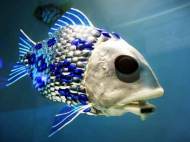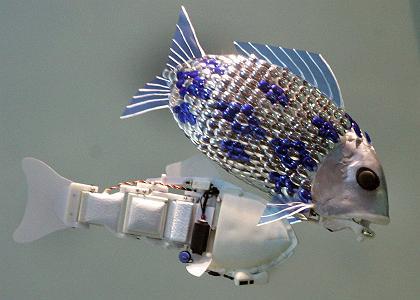Fish robots search for pollution in the waters
 A number of robotic fish are going to be used in an experiment in the port of Gijon in Spain in order to evaluate how effectively and cost-efficiently they can detect water pollution. The carp-shaped robots are part of a three-year research project of Huosheng Hu and his robotics team at the School of Computer Science and Electronic Engineering, University of Essex. The robot fish could be used to inspect rivers, lakes and seas.
A number of robotic fish are going to be used in an experiment in the port of Gijon in Spain in order to evaluate how effectively and cost-efficiently they can detect water pollution. The carp-shaped robots are part of a three-year research project of Huosheng Hu and his robotics team at the School of Computer Science and Electronic Engineering, University of Essex. The robot fish could be used to inspect rivers, lakes and seas.
The life-like creatures, which mimic the undulating movement of real fish, are 1.5 meters (5 feet) long and will be equipped with tiny chemical sensors. These sensors are used to find sources of potentially hazardous pollutants in the water, such as leaks from vessels in the port or underwater pipelines. When they recharge their batteries via a “charging hub” they will be able to transmit the information to the port’s control center. This will enable the authorities to map the source and scale of the pollution virtually in real time.
The robot fish have autonomous navigation capabilities, enabling them to swim independently around the port without any human interaction. This enables them to return automatically to their hub to be recharged when battery life (approximately eight hours) is low.
“I am incredibly excited about this project. We are designing these fish very carefully to ensure that they will be able to detect changes in environmental conditions in the port and pick up on early signs of pollution spreading, for example by locating a small leak in a vessel.”, Hu said, “The hope is that this will prevent potentially hazardous discharges at sea, as the leak would undoubtedly get worse over time if not located.”
The project is being coordinated by BMT Group Ltd, an independent engineering and risk management consultancy. Rory Doyle, senior research scientist at BMT Group, described the project as a “world first”, adding that scientists involved in designing the fish were using “cutting-edge” methods to detect and reduce water pollution.
“While using shoals of robotic fish for pollution detection in harbours might appear like something straight out of science fiction, there are very practical reasons for choosing this form”, he said.
“In using robotic fish we are building on a design created by hundreds of millions of years’ worth of evolution which is incredibly energy efficient. This efficiency is something we need to ensure that our pollution detection sensors can navigate in the underwater environment for hours on end”, said Hu.“We will produce a system that allows the fish to search underwater, meaning that we will be able to analyse not only chemicals on the surface of the water (e.g. oil) but also those that are dissolved in the water.”
By controlling the environment for pollutants and providing feedback about the condition of the waters, this project should bring us a step closer to a greener future.










Water pollution is a concern for the world. It is not something limited to poor nations. Many people think that only poor countries suffer from the lack of clean drinking water and pollution of water. That is far for the truth. I think the biggest source of water pollution is Industries. Who are releasing large amount of hazardous waste into our water resources.
it is so good.